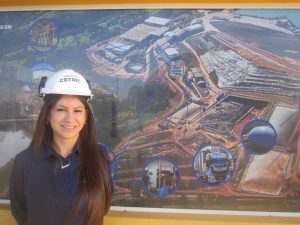
Loana Defaveri, technical manager of Cetric, is photographed at the bioenergy ecopark in Chapecó in southwestern Brazil. The aerial photo in the background shows the various components of the complex, which receives industrial waste and produces biogas, electricity, biomethane and other by-products. CREDIT: Mario Osava / IPS
By Mario Osava
CHAPECÓ, Brazil , Apr 29 2024 – Biogas sounds like redemption, the conversion of the sinner. Its production involves extracting energy from filth, from the most disgusting environmental pollution, and at the same time avoiding the worsening of the global climate crisis.
The Industrial and Commercial Solid Waste Treatment Center (Cetric) is dedicated to extracting biogas from the waste that abounds in the municipality where it is based, Chapecó, in southern Brazil. “Making use of industrial waste is an important and innovative niche in Brazil, opening up new paths for the emerging biogas market.” — Heleno Quevedo
With a population of 255,000 and numerous meat processing plants, Chapecó is a main hub in the western part of the state of Santa Catarina, the largest national producer and exporter of pork and also a major poultry producer.
For this reason, biogas production is proliferating in the region, using manure from pig farms, partly due to pressure from environmental authorities to prevent animal waste from continuing to contaminate rivers and soil to the detriment of the environment and human health.
On Apr. 3, the Federation of Santa Catarina Industries launched the Decarbonization Hub program, with the goal of treating 100 percent of swine manure in the next 10 years, among other challenges to meet the agreements to reduce greenhouse gas emissions. It does not seem feasible, but it points in the right direction.
The Cetric group of companies was founded in 2001 with a specific mission: to take care of waste from nearby agribusiness and other smaller sources, from its evaluation and collection to its transportation, processing and disposal.
It then expanded nationally. Today it is active in 12 of Brazil’s 26 states, with four Bioenergy Ecoparks, including the first one in Chapecó, 17 transshipment units with warehouses and 19 emergency teams at strategic points.
“Making use of industrial waste is an important and innovative niche in Brazil, opening up new paths for the emerging biogas market,” said Heleno Quevedo, an energy engineer and creator of the news portal Energía e Biogás, in a telephone interview with IPS from Santo André, a city neighboring São Paulo, also in the south.
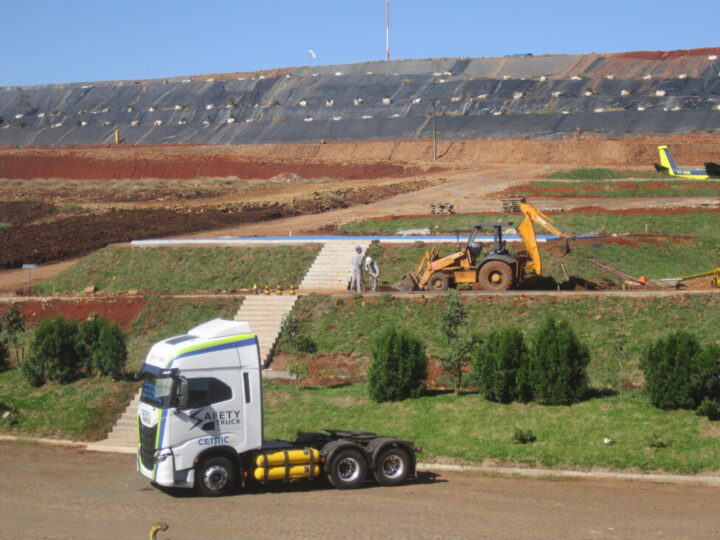
The photo shows a truck running 100 percent on biomethane and, in the background, the industrial waste landfill in Chapecó, in southwestern Brazil. The company Cetric acquired another 28 trucks that will use fuel from its own production. CREDIT: Mario Osava / IPS
Industrial waste as a business
Cetric’s business is the management of waste wherever it is, not just landfills, chemical engineer Loana Defaveri, the company’s technical manager, told IPS. Guidance on the handling of this material in industries is part of their activity.
The company also acts in emergencies, such as accidents with dangerous loads on highways, cities or production sites. It is a kind of firefighter in these cases and deploys specialized personnel with the necessary tools and vehicles for prompt assistance, dispersed throughout 19 locations in the country.
In mid-April, a team dealt with a spill of propionic acid, used to preserve food, when a truck overturned in Paraná, a neighboring state. The most frequent are accidents involving trucks carrying fuel such as ethanol and diesel, Defaveri said at the company’s facilities.
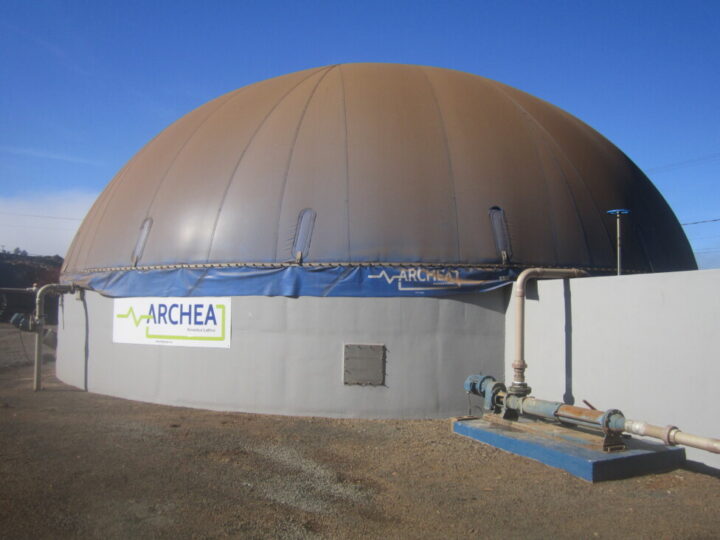
The CSTR reactor is more productive than covered lagoon biodigesters because temperature, acidity and other indicators of the substrate that generates biogas are controlled. CREDIT: Mario Osava / IPS
A Command Center, a rotating team of four people, monitors by video the fleet of more than 200 Cetric trucks 24 hours a day from the company’s headquarters and the emergencies addressed.
But the ecopark in Chapecó is the heart, the center of innovations and the circular economy of the Cetric Group, which is involved in a range of activities.
Bioenergy production began in 2005, but was suspended due to the scarcity and low durability of biogas equipment. It resumed 15 years later and now has five covered lagoon biodigesters and a continuous stirred tank reactor, known as CSTR.
Only organic material is used for this purpose. The waste collected by the company is class 1, hazardous waste, generally chemical, and class 2, which includes inert waste such as iron scrap or concrete, and waste that degrades, such as organic waste, which is the bioenergy part.
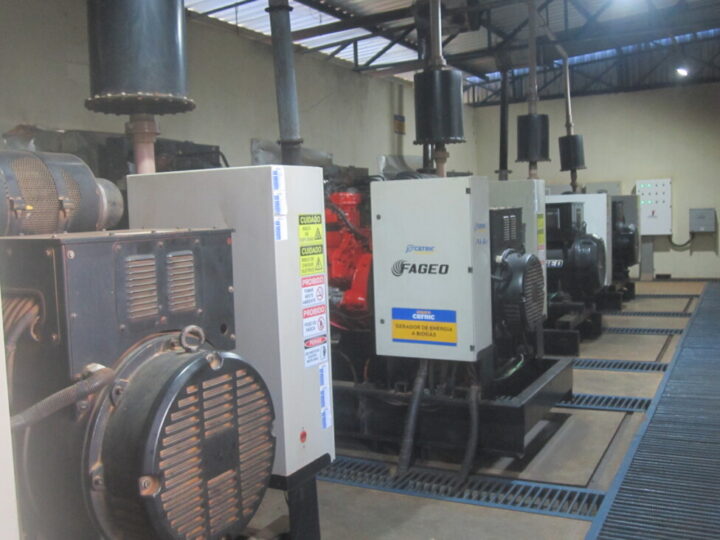
Four generators produce one megawatt of electricity with the biogas produced at Cetric’s own ecopark. This power supplies the consumption of the Brazilian company’s industrial solid waste treatment complex. CREDIT: Mario Osava / IPS
Biogas from landfills and biodigesters
From the large landfill covered with impermeable black tarpaulin, which accumulates most of the garbage, biogas is extracted that only serves to generate heat, because it contains little methane, Defaveri explained. Burning this biogas reduced 80 percent of the firewood previously consumed in the ecopark.
For electricity generation and the refining that converts it into biomethane, the biogas that comes out of the biodigesters, which has 71 percent methane, and the reactor, with 73 percent, is used, she said.
In this energy sector, four biogas generators produce one megawatt of power, electricity estimated to be sufficient for the company’s consumption.
Another part of the biogas is refined by membranes, activated carbon and other processes to remove carbon dioxide (CO2) and sulfuric acid (H2S) to obtain biomethane, which is the fuel used by a 100 percent gas truck and 15 other hybrid trucks that consume gas and diesel.
Another 28 trucks recently acquired in Chapecó will also use 100 percent biomethane or natural gas as fuel, as the two gases are equivalent.
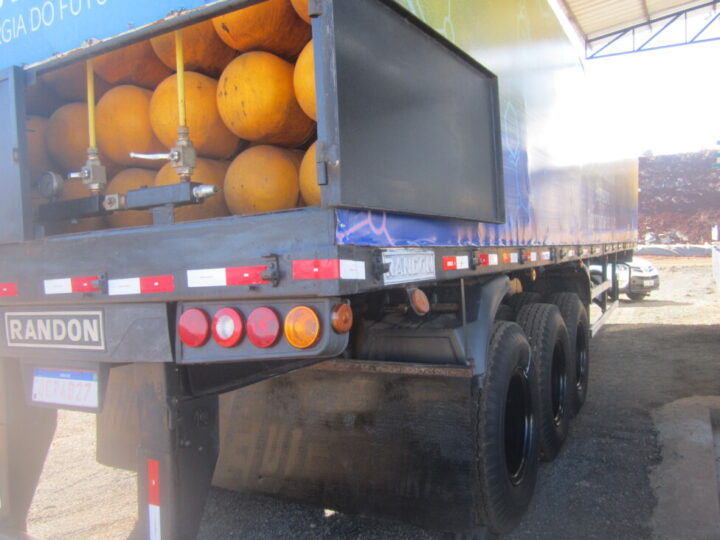
A truck stores biomethane in yellow cylinders, ready to supply trucks transporting industrial waste being treated at the Cetric Ecopark in Chapecó, a municipality in southern Brazil. CREDIT: Mario Osava / IPS
Productivity still low
But production is still not very efficient, despite the progress represented by the CSTR reactor. “We only produce 10 percent of our biogas potential, but we are increasing productivity with technological advances, new investments and personnel training,” Defaveri noted.
Cetric Chapecó currently produces 250 cubic meters of methane per hour and intends to reach 1,500 cubic meters per hour, i.e. six times the volume, which requires heavy investment and also depends on the substrate, as they call the input, she said.
The effluent resulting from this process undergoes a complex treatment, which includes waste separation, sand filters, membranes, electrolysis and even a reverse osmosis device.
This makes it possible to obtain water of sufficient quality for reuse in washing vehicles and other equipment, chemical engineer Diego Molinet told IPS. The solid part goes to composting for processing that can result in biofertilizer.
The effluent cannot be used as fertilizer, a common practice among small biogas producers such as pig farmers, because it can saturate the soil, with an excess of some components, such as phosphorous, said Molinet.
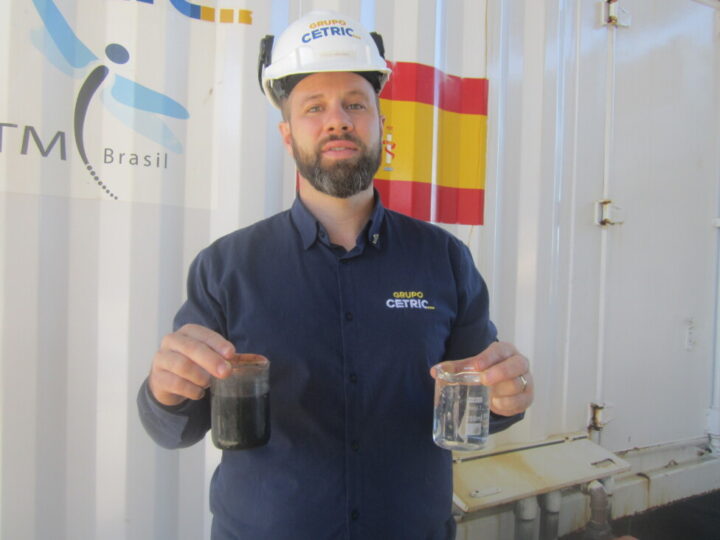
Diego Molinet, a chemical engineer at Cetric, holds in his hands the result of the treatment of effluents from the industrial waste treatment process, with production of biogas and biomethane: a glass with clean water for non-potable reuse and another glass with solid material that can be converted into fertilizer after composting. CREDIT: Mario Osava / IPS
Effluent treatment also produces ARLA 32, a pure urea compound that is mandatory in heavy vehicle exhaust to reduce the emission of pollutant gases, such as nitrogen oxide. It is of growing use in the automotive industry.
“Cetric enjoys a good reputation” and plays an important role in Chapecó by preventing the city from having to send its industrial waste to other municipalities, Marck Gehlen, the city government director of the environment, told IPS.
Its emergency service has already controlled several accidents in the city. One was a fire at a fuel distribution company, whose rapid control prevented contamination of water courses and risks to the population, said Gehlen, an environmental engineer who has worked in the sector for more than 10 years, three years as director.
One concern is the sometimes dangerous truckloads of industrial waste that crisscross the city, he admitted.
With four meatpacking plants on the periphery of the city, Chapecó has had some problems, such as the stench emitted by the plants, although that was brought under control years ago. In general, the companies have adopted measures to avoid environmental damage and one of them has already transferred potentially polluting activities away from the city.